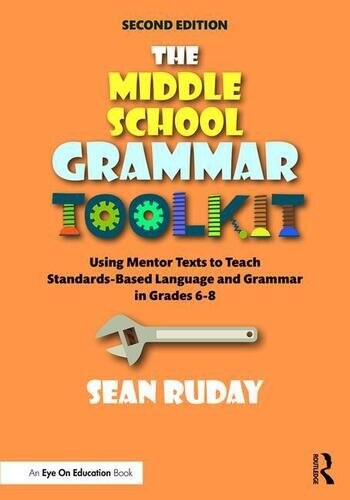About the Book: The Middle School Grammar Toolkit: Using Mentor Texts to Teach Standards-Based Language and Grammar in Grades 6-8
Posted on: October 2, 2020
The Middle School Grammar Toolkit
Using Mentor Texts to Teach Standards-Based Language and Grammar in Grades 6–8, 2nd Edition
By Sean Ruday
 Impact
Impact
The Middle School Grammar Toolkit provides middle school teachers with a research-based and practitioner-oriented guide to mentor-text based grammar instruction. Grammar can be overwhelming for both teachers and students and is often seen as an endless set of rules to be memorized in ways that are disconnected from effective writing instruction. This book disrupts that idea by providing teachers with an accessible resource that will help them rethink how and why grammar should be taught. In this book, teachers will learn how to reconceptualize grammar instruction through the use of relevant mentor texts that help students see grammatical concepts as important tools for effective writing. I believe this book will impact grammar instruction by helping teachers present grammatical concepts to students in engaging, meaningful, and relevant ways that promote metacognition and deep understandings.
 Highlights
Highlights
One aspect of The Middle School Grammar Toolkit that I believe will be especially impactful to the audience is the wide range of contemporary mentor texts that not only demonstrate how authors use key grammatical concepts, but also demonstrate these concepts' use in relevant and engaging texts. Readers will encounter excerpts from graphic novels such George Takei’s (2019) The Called Us Enemy, memoirs such as Trevor Noah’s (2019) It’s Trevor Noah: Born a crime. Stories from a South African Childhood. Adapted for Young Readers, and a range of other fiction and nonfiction texts that incorporate a variety of perspectives and backgrounds. Examining grammatical concepts in this range of works and genres can ensure that students understand how a wide variety of writers use grammatical concepts to enhance their works. In addition, showing middle school students examples from this range of texts will help ensure they work with a number of genres during literacy instruction.
Another component of this this book that will impact readers is the classroom “snapshot" sections. Each “snapshot” contains a description of my experiences teaching the chapter's focal concept to a middle school English class during my recent work as a grammar and writing instruction consultant at a middle school. I have included these “snapshots” so you can see how I taught my students about these grammatical concepts and learn from these concrete examples as you work with your students.
In addition, I believe readers will benefit from the way each chapter from one through twelve contains flowcharts that visually represent the instructional recommendations described in that chapter. These flowcharts are designed to make the instructional processes discussed in the book visually appealing and even more accessible.
 Research
Research
I greatly enjoyed working with the middle school English classes featured in the classroom "snapshot" sections. The curiosity and genuine interest the students in those classes demonstrated in learning about grammatical tools and concepts conveyed to me how much students can engage with and benefit from relevant and thoughtful grammar instruction that uses a wide range of interesting mentor texts.
 Development
Development
This book is a revised and updated edition of my 2014 book The Common Core Grammar Toolkit: Using Mentor Texts to Teach the Language Standards in Grades 6-8. When creating this new text, I listened to what teachers who purchased the first book had to say about what they liked and what they wanted to see more of and acted according to those insights! Based on readers' feedback, I added flowcharts to chapters, maximized the usefulness of the classroom snapshots, and incorporated even more contemporary mentor text examples from a wider and more diverse range of authors.
In connection with the always-changing nature of the English language, I added information that that addresses the idea that pronouns are evolving, especially in the interest of being inclusive of all gender identities, and that teachers should continue to be aware of this evolution of language. I cited NCTE’s Statement on Gender and Language as a resource related to this topic.
Also, I changed the title from The Common Core Grammar Toolkit: Using Mentor Texts to Teach the Language Standards in Grades 6-8 to The Middle School Grammar Toolkit: Using Mentor Texts to Teach Standards-Based Language and Grammar in Grades 6-8, Second Edition. This title change reflects the fact that the grammatical concepts discussed in this book are relevant to effective grammar and language instruction in all contexts, whether a school uses the Common Core State Standards or not. The Common Core Language Standards are similar to many other rigorous state standards and this book is designed to be useful to teachers in states and schools that both use and do not use the Common Core.


